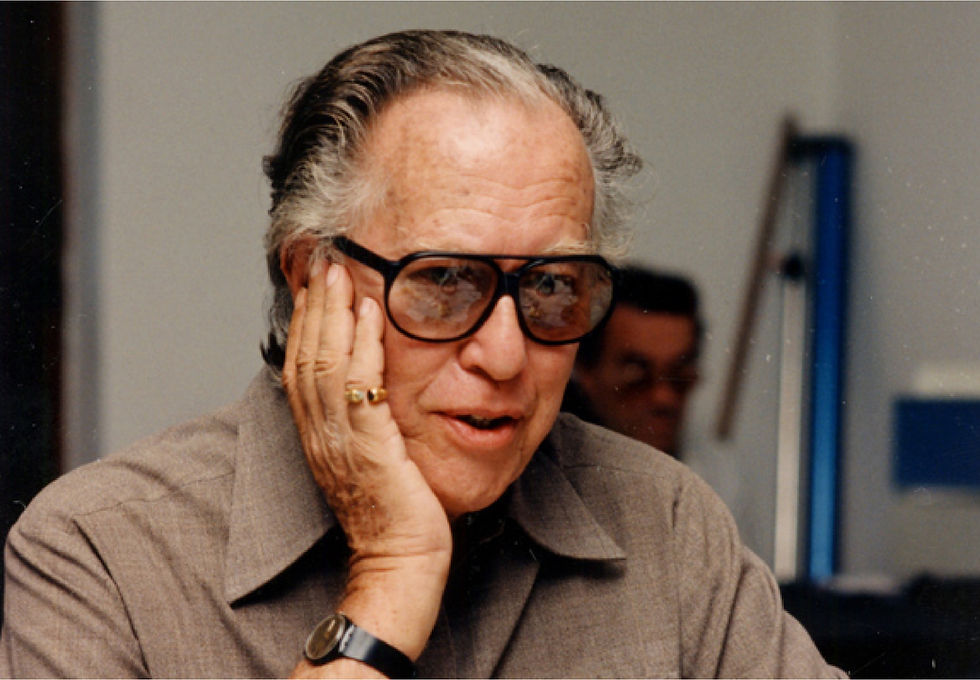Crawford House: Culture War Casualty
- tipsy modernist
- Dec 13, 2023
- 4 min read
Updated: Dec 15, 2023

I know. Another article about Paul Rudolph!? Why, you ask? Well because a couple of weekends ago, Mr. Don't Bruise the Booze and I were in New Haven to check out the modernist architecture (If you’re a fan of Modernism put this city on your list) and one of the first buildings we saw was Paul Rudolph’s Crawford House and it was love at first site. The building is stunning. If you’re a fan of brutalism, you will love it. If you hate brutalism (because there seems to be no in-between with brutalism- you either love it or hate it.) you’re probably not going to like it. But even if you’re not a fan of brutalism, I hope you'll find the cultural war between modernism and post modernism that took place over the building fascinating.

LEARNING FROM LAS VEGAS
Somewhere around 1972, Denise Scott Brown and Robert Venturi published the architectural manifesto “Learning from Las Vegas” which effectively began the end of the modern movement and ushered in the era of “post-modernism” in architecture. In the book, Denise Scott Brown and Robert Venturi specifically singled out Crawford House as an example of “establishment architecture”, whose crime against architecture apparently was that it was “heroic and original” rather than “ugly and ordinary”. I am not making this up. I read this book so you don’t have to. Suffice it to say, it reads like a parody of architecture.
With chapter headings like, Theory of Ugly and Ordinary and Related and Contrary Theories or Against Ducks, or Ugly and Ordinary Over Heroic and Original, or Think Little, you might think this was some sort of farce written by Monty Python's Flying Circus. But no, not only was this book deadly serious but it was incredibly influential. So influential in fact, that the critique of Crawford House as culturally and aesthetically obsolete was the final nail in the coffin for Paul Rudolph’s architectural career. As his biographer Timothy Rohan put it “A small but influential cadre of architects in the early 1970’s picked up on the idea that Rudolph’s architecture was ‘irrelevant' … They no longer admired Rudolph as a bold figure who was challenging modernism’s verities; rather they disdained him as a member of the Establishment.” 1 As a result by the late seventies/early eighties Crawford House became a symbolic punching bag for the type of "heroic" architecture that was considered dated and self-aggrandizing.
UGLY and ORDINARY


OK. I get that alot of people don't like brutalism, but the architecture pictured above* is somehow better? It's astonishing to me that the building with which Crawford House was so unfavorably compared as to make Paul Rudolph irrelevant, was Guild House (by Venturi Scott-Brown), which by their own admission is an “ugly and ordinary” building. I think this description is up for debate. Personally I find this building extraordinarily ugly and I apologize if the photo makes you feel like someone just stuck a fork in your eye. Apparently in the upside-down world of Denise Scott-Brown and Robert Venturi, ugly and ordinary is what architecture should aspire to be and heroic and original is something to avoid.

GIVE 'EM WHAT THEY WANT
This entire book seems to be a justification for the negative criticism they received for one of their first major commissions, which was described as ordinary and ugly. In what can only be described as Trumpian fashion, Venturi Scott Brown leaned into this criticism, essentially saying, "YES! That is exactly what we were aiming for! Cheap, ugly and accessible architecture, is what everyone should design!" And it worked. A generation of architects were taught to think of buildings as two- dimensional billboards and to design cheap, ugly and ordinary buildings because developers/clients don't want to pay for beautiful architecture and society doesn't really care either way. And it's not for architects to try and change society because that would be Utopianism which everyone knows was a massive fail.
"Whether society was right or wrong was not for us at the moment to argue."2

Needless to say this made for some awkward encounters between Denise Scott Brown and Paul Rudolph, culminating in a notorious screaming match between the two at a cocktail party at Robert Stern's home.3 Robert Venturi reportedly wrote a letter apologizing to Rudolph for singling him out, explaining that he didn't realize the massive influence the book would have or that it would put an end to Rudolph's architecture career in the US. I actually believe this statement- who would believe that such a ridiculous book would ever attract a following let alone become a new design movement.
I'm sure that letter meant a lot to Rudolph as he surveyed the smoldering embers of his career. Of course Learning from Las Vegas wasn't the only reason Paul Rudolph's work fell out of favor, as I wrote in a previous post . Since then the tides have turned and the work of Paul Rudolph has undergone a critical re-appraisal due to the resurgence in popularity of modernism and brutalism. But it's a shame that this glorious building was thought of as an example of everything that was "wrong" with modernism and brutalism for so many decades. Thirsty for More? Don't forget to check out this week's cocktail- the Yale!!

Shoppables!
Notes
1.Rohan, Timothy. The Architecture of Paul Rudolph. pp.177 Yale University Press 2014. 2.Venturi, Robert , Scott-Brown,Denise and Izenour, Steve Learning From Las Vegas pp.128 MIT Press 1972. 3. Archived conversation with Robert Stern and the Tipsey Modernist

While I admit to being biased toward brutalism and against post-modernism, I scoured the internet to find a flattering picture of Guild House, I really did. There are none because it is simply not possible to make that hideous building look anything other than its authentic, hideous self.
















Comments